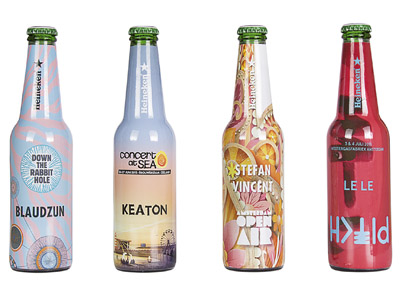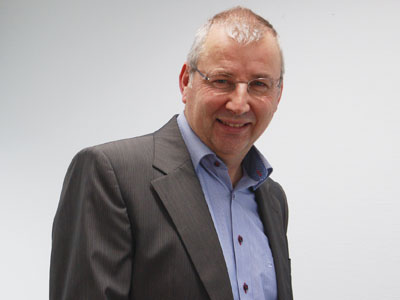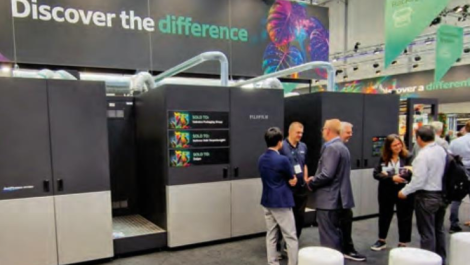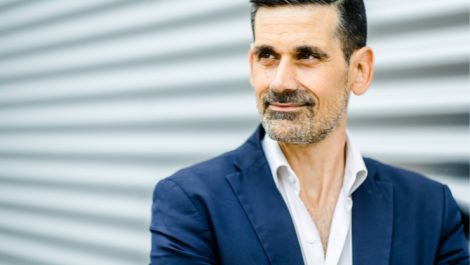Peter Overbeek, Eshuis CEO
Interview with Peter Overbeek, CEO of Eshuis, by Des King.
Eshuis, in the Netherlands, is one of HP’s longest-standing customers, and having been used regularly as a reliable beta site for successive new additions to the manufacturer’s portfolio currently operates three WS6800 presses (also a Xeikon 8500) as well as having access to the flexible packaging 20000 system.
The privately-owned company will be forever associated with the ground breaking ‘Share a Coke’ campaign in which it played a pivotal role by setting up and managing the network of eight other HP label manufacturers. The campaign captured the imagination of delighted Coke drinkers and rival brand owners alike – and customisation morphed seamless from being a relatively under-used trade secret to a must-have brand-marketing imperative almost overnight.
Since then, Eshuis was directly instrumental in developing the equally eye-catching and significantly more complex Coke ‘bow label’ in conjunction with Constantia Flexibles, which has gone on to garner any number of best in class industry plaudits. It won the packaging innovation category at the FlexoTech Awards last year.
CEO Peter Overbeek charts a digital journey that started 15 years ago and which through a talent for innovation and a knack for forming strategic partnerships has helped the privately-owned Eshuis almost double its turnover to around €20 million in the process.
When and why did you extend into digital print?
We installed HP’s ws2000 press in 2002, and subsequently the ws4000 two years later. Prior to that Eshuis had been running both flexo and offset for self-adhesive labels and flexible packaging, but the amount of pre-press involved was making it impossible to fulfil the smaller volumes at shorter lead times that our customers were expecting. For example, we were printing a lot of sachets for vegetable and flower seeds but in very small quantities for which the number of plates required was enormous – whereas with digital you just RIP from pre-press and start printing; so much easier. That was the main reason for investing at that time.

Personalised Heineken neer bottles digitally printed for various events
What were the main challenges you had to address?
As one of the first printers in the Netherlands to adopt digital, we were ahead of the competition, but likewise very much on our own. We went with HP because we felt that they offered the best quality, the best solution – and we’ve always maintained very good contacts with them. We were giving them lots of feedback on all the issues that we were struggling with, and over the years they have improved everything that we mentioned in those early days. But the reason we get a better performance than the competition from our presses is because we have a very dedicated team of people who are determined to make the best out of the presses and are just very passionate about digital printing.
And what have been the main gains?
Well, obviously in reducing the volume of plates we needed to produce, but also in terms of pre-press using all our capabilities in being able to exchange jobs between analogue and digital. We have some top-level pre-press people here who understand all about colour management and do a perfect job in ensuring that we exchange the files between the technologies as necessary and without the customer ever noticing any difference. In fact, maybe 70% of all the files that now come in are digital. Meanwhile, in terms of outputting volume I’d say that we’re printing 20% digital.
How has customer awareness of digital developed over the years?
Not that much specifically. They know it’s there, of course, so for example they’re now used to ordering labels with short lead times, of say a couple of days, in the sure knowledge that it can be done. The bottom line though is that they don’t care about printing technology; they want a good label or good packaging at a fair price.
It’s really about the economics of short runs, however, and only a small portion of the true potential of what digital can deliver. Actually, my biggest problem today is that there’s still the need to educate brand owners, because even some of the big names don’t have a clue about what’s going on in the digital printing world.
And how has digital helped you and them to develop your businesses?
There are some brand owners who still need 18 months to prepare a marketing campaign; these are multi-nationals too, and this is what their system allows them to do. It’s completely the reverse of what you can do today with digital print capabilities, which can enable you to put together a campaign in a couple of hours if necessary. The systems are leading, and this is the problem for most companies should they want to do things in a different way than before. You need to have creativity and a flexibility that their supply chain simply doesn’t allow for.
There are other companies, however, which see their market share maybe going down a little bit and so need to do something to halt that slide – and that’ll mean customer attention, customer awareness and more customer engagement. They do these campaigns to get back in business, and if you do them successfully then they really work.
I see a shifting role for us as a traditional converter as well to being more of a service provider and even project management, such as the network of eight European printers we assembled and ran for the ‘Share a Coke’ campaign, which depended upon a degree of co-operation that’s not always there in our industry.
It’s now a model I’m quite used to, and when there is trust then you can easily do it. One unanticipated benefit from it has been a partnering arrangement we now enjoy with one of those competitors to use the new HP 20000 press. Everyone knows that when you work together with other companies you’re far stronger; you can do much more than on
your own.
Looking back is there anything you wish you’d done differently?
I don’t think there is. I’ve been very happy to have had such an open relationship with HP that has led to improvements year on year, namely ease of operation; the development of an end to end solution; and more and more options. It’s always a question of when to invest though, of course; you install a new machine this year, and by next year there’s another, better version that comes along with added capabilities.
What advice would you give to anyone adopting digital now?
Years ago I was asked that same question, and my very short answer was, ‘Go for it.’ If you don’t have digital capabilities today then I’m not sure whether you’ve really understood the concept, because to my mind it’s something that you cannot do without.
It’s not only short runs, it’s what you can do with versioning, personalisation, augmented reality, invisible digital codes you can incorporate to fulfil security requirements. There are so many things you can do using HP’s Mosaic software which enables you to make every pack or label unique. With these capabilities you should be able to conquer the world; certainly to enthuse the brand marketers and show them what can be done.
How do you see the future for digital print for packaging?
I think if the promise of a 1 metre wide press running at a speed between 100-200 m/min comes good then it will destroy maybe 90% of all conventional printing. I know that there are HP people moving to Landa. I do think that they’ll get there, but when and what the quality will be like, who knows? But there is a big market that’s suitable for this technology. We have enquired about the price. It’s quite expensive, but it’s a huge volume you need to address with such a device so that’s another issue. Maybe if you were working together in a network then you could share this technology.
In the meantime, we’ve done some trials with inkjet and it looks pretty interesting, although there are still some technical hurdles to overcome, for example, there’s a thick ink layer, which may cause problems. It is a very promising technology although I did hear anecdotally that not too many presses are actually being sold. I would have expected it to be more.
Read the full issue here






